Hot working is a process in which a metal, above its recrystallization temperature, is deformed and strain hardening does not occur. Normally, hot working refers to procedures performed at temperatures of 0.5-0.75Tmelting (in oK). It should be noted that the forming of lead at room temperature can be considered a hot working process because of lead's low melting temperature.

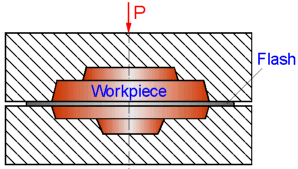 Flash is formed when a minute amount of a metal flows outside the die during hot forging. The flash cools faster than the bulk of the workpiece because it is much less thick. This increases the resistance of the flash to deformation and forces the bulk to flow inside the die cavities.
Flash is formed when a minute amount of a metal flows outside the die during hot forging. The flash cools faster than the bulk of the workpiece because it is much less thick. This increases the resistance of the flash to deformation and forces the bulk to flow inside the die cavities.
Features of Cold Working vs. Hot Working
Better surface finish.
Increased dimensional control due to elimination of shrinkage during cooling.
Strength and wear properties of metal parts are higher while keeping the ductility lower.
Large deformation results in a greater tensile and yield strength along with a lower ductility.
Directional properties of metal parts can be formed.
Less contamination problems.
More powerful equipment is needed.
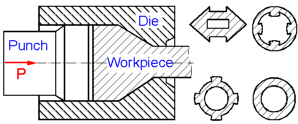 Extrusion is used to produce solid or hollow parts with long lengths of constant cross-section. Extruded products include both simple as well as complicated cross sections (eg. internal ribs) that can not be produced by any other techniques of material forming.
Extrusion is used to produce solid or hollow parts with long lengths of constant cross-section. Extruded products include both simple as well as complicated cross sections (eg. internal ribs) that can not be produced by any other techniques of material forming.
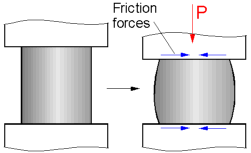 Friction between the contact surfaces is known to cause uneven compression of the deforming materials upon upsetting. This results in the barreling of the workpiece.
Friction between the contact surfaces is known to cause uneven compression of the deforming materials upon upsetting. This results in the barreling of the workpiece.
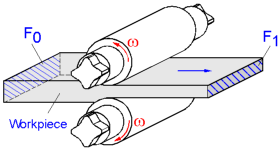 The length of the rolled workpiece is increased proportionally to the decrease of its cross sectional area. During rolling the volume of the material remains constant:
The length of the rolled workpiece is increased proportionally to the decrease of its cross sectional area. During rolling the volume of the material remains constant:
F0 l0 = F1 l1,
where F0, F1 - the cross sectional area before and after rolling respectively; l0, l1 - initial and final length of the workpiece.
Hence: l1 = l0 F0/F1
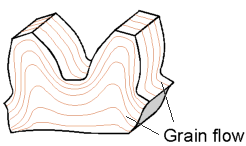 Forging refines the grain structure and improves the physical properties of the metal. Grain flow is defined as the direction of the pattern that the crystals take during plastic deformation. The grain flow can be oriented in the direction of principal stresses encountered by the piece.
Forging refines the grain structure and improves the physical properties of the metal. Grain flow is defined as the direction of the pattern that the crystals take during plastic deformation. The grain flow can be oriented in the direction of principal stresses encountered by the piece.
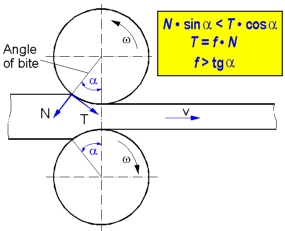 The figure on the right dispays the forces acting on a workpiece from the rolls at the point of contact. Where N - normal force; T = f N - friction force; f - the coefficient of friction.
The figure on the right dispays the forces acting on a workpiece from the rolls at the point of contact. Where N - normal force; T = f N - friction force; f - the coefficient of friction.
The workpiece will be drawn forward if
N sin(a) < T sin(a) or f > tg(a)
where a - the angle of bite.
If friction between the contacting surfaces decreases the maximal possible angle of bite is reduced.
 2015-08-13
2015-08-13 380
380








